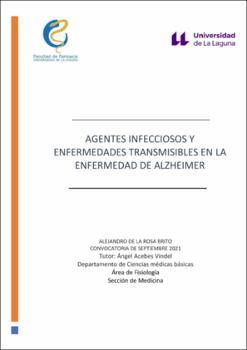Agentes Infecciosos y enfermedades transmisibles en la enfermedad de Alzheimer
Author
Rosa Brito, Alejandro De LaDate
2021Abstract
La enfermedad de Alzheimer es considerada en nuestros tiempos como una
enfermedad neurodegenerativa agresiva y devastadora que afecta a la calidad
de vida de un gran número de pacientes en todo el mundo. A pesar de su
prevalencia, se desconocen aspectos que son claves para entenderla y poder
combatirla. Entre ellos, su etiología o los mecanismos por los cuales se induce
la formación de las placas de péptido beta amiloide y los ovillos neurofibrilares,
las principales y clásicas lesiones que aparecen en el tejido cerebral. Los
objetivos de este trabajo bibliográfico han consistido en documentar y analizar
nuevas vías que podrían estar implicadas en la causa y desarrollo posterior de
la enfermedad, incluyendo agentes infecciosos, como el virus del, como los
priones. En este trabajo se han explicado las propiedades fisiológicas de todos
ellos y su relación con la patogenia de la enfermedad de Alzheimer. También
se discute si estos elementos se podrían tener en cuenta, en un futuro próximo,
como factores de riesgo en pacientes, e incluso si pudieran ser empleados para
un mejor diagnóstico de esta terrible enfermedad neurológica. Alzheimer's disease is considered nowadays as one of the most aggressive and
devastating neurodegenerative diseases that affect the quality of life of a large
number of patients Despite this threat, certain key aspects needed to
understanding this pathology are still unknown among then its etiology and the
underlying mechanisms by which the formation of beta amyloid plaques and
neurofibrillary tangles, the main classical pathological lesions appearing in brain
tissues, are induced. The main objectives of this work have addressed new
ways suggesting how this disease is able to spread in patient’s brain, including
infectious agents and transmissible vectors such as prions, herpes viruses
Here, by explaining its physiology and properties in relation with the pathology
of Alzheimer's disease, this work points towards whether this elements can be
considered in the near future as risk factors in patients, and, in the long run,
whether they can be helpful in order to obtain a better diagnosis of this
neurological disease.





